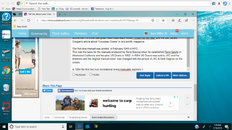Every year for ten years i have been honored as the first presenter at the annual SLO (San Luis Obispo) Sheriffs UW S&R Dive conference.
My presentations are always historical based on a in-depth researched item or event in the very short history of recreational diving.
This year my subject was "Dive Manuals "
(Dr. Sam Miller III Dive Historian -- Published UW Photographer and Author
“Early Development of Recreational Training Manuals”)
The exposure to recreational diving in the US began in 1948 with the showing in movie houses all across the US of the late great Hans Hass B&W movie "Under the red Sea" and the late James Dougan's article about "Cousteau Divers" in a scientific magazine.
The first dive manual was printed in February 1949 in NYC .
This was the basis for the manuals produced by Rene Bussoz when he established Rene Sports in Westwood, California and became US Divers in 1952. In 1954 US Divers was sold to JYC and his investors and the original manual cover was changed with the picture of JYC & Emil Gagnon on the covers-theses were produced until around 1960
in 1954 the first two true recreational diving manuals appeared LA County's Diving Safety
and the late ER Crosses manual of the same name Diving safety.
In 1955 LA Co changed the name of their manuals to Underwater Recreation so as not to be in conflict with ER. - Both manuals stressed learning Skin ( Snorkeling) and followed by the use of the Aqua Lung -- SCUBA was not in common use at that time
In 1957 Bernie Empleman et al produced a manual titled The Science of Skin and SCUBA diving which was changed in 1959 to The NEW Science of Skin and SCUBA diving. Note "Skin & SCUBA " diving .
These manuals served as the basis for manuals which followed which are too numerous to list ,. but were produced by individuals and most of the dive companies and training organizations to promote products or their agency.
La County's Recreational Diving and The New Science of Skin and SCUBA was continually up dated and were/are possibly the two best sources of dive training at a particular time in history, They both stressed Skin ( aka Snorkeling / free diving ) as a component of complete dive training.
The last diving manuals of NAUI & PADI produced I the early 1980s stressed Skin (snorkeling ) followed by SCUBA training ..An interesting note - the1984 PADI dive manual was written by a NAUI instructor and assisted by several LA Co UW instructors.
Then around 1980 Skin diving was deemphasized and the diving population was not taught to 'Snorkel" This as resulted in the current crop not having training in snorkeling or considering it a component of modern diving, What a shame!
Now it is possible to walk down a diving beach or set on a dive boat and the divers who were trained after 1980s by the lack of a snorkel on their mask and the requirement that they have a Qualified Dive Master to guide them and hold their hand on the first 100 dives- or during their generally short diving career
Interesting how equipment and training has changed..
Sam Miller,III
PS,, dive manuals are still cheap and readily available on the used book market, they offer a glimpse in the history of diving - equipment and training procedures at the particular time of their publication. sdm




